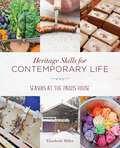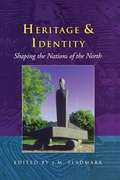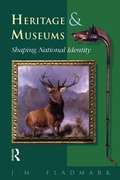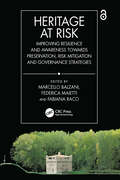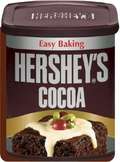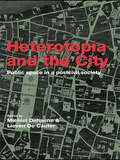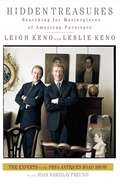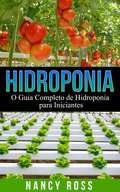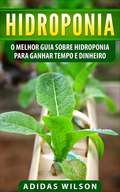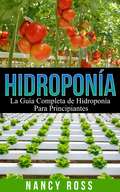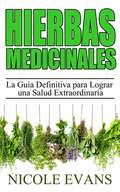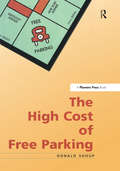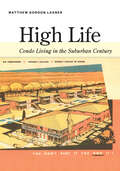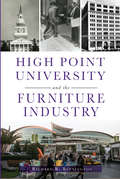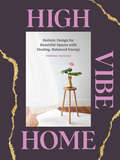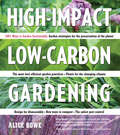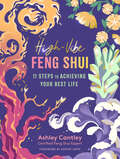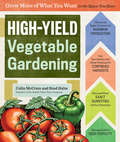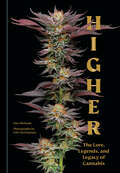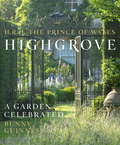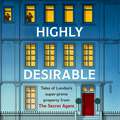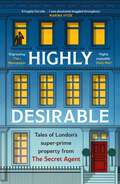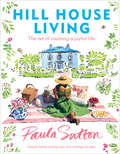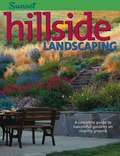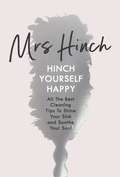- Table View
- List View
Heritage Skills for Contemporary Life: Seasons at the Parris House
by Elizabeth MillerNearly twenty years ago Beth Miller moved with her husband and four young kids from suburban New Jersey to a 200-year-old Federal period house and barn in rural Maine. She didn&’t garden, she didn&’t keep chickens or bees, she didn&’t know how to preserve food, and she didn&’t know how to make soap or hook rugs. She embarked on a journey to learn these heritage skills that have been largely forgotten, and today she owns and operates Parris House Wool Works, a traditional rug-hooking company serving both crafters and end buyers. It is also a working village homestead and workshop where she practices and teaches heritage skills, including all aspects of gardening, beekeeping, rug hooking, preserving, and soap making. Seasons at the Parris House is separated into seasonal sections and includes historical context and homestead related activities for each season, plus instructions for a set of related projects and recipes.
Heritage and Identity
by Thor Heyerdahl J. M. FladmarkWas the shaping of nation states in Northern Europe governed by military might, or by Christian and democratic ideals? How has trade and cross-cultural exchange between Scandinavia and the British Isles shaped our historic identities, and what about the impact of global politics and marketing in recent times? These are some of the questions explored by the contributors in the context of forces that shape national identities today. Their analysis highlights the need for historical awareness when developing future cultural policy, brand profiles and marketing strategies. Looking back, Jesse Byock tells how democracy was first embraced in the north by the early settlers of Iceland, Bjorn Myhre delves into the unpredictability of historical interpretation, Edward Cowan discusses the role of 'battles and beddings' in relations across the North Sea, John Purkis writes about William Morris' fascination with Nordic culture, Stephen Harrison presents the 'winning ways' of product development and marketing by Manx National Heritage, whilst Chris Powell looks at 'Cool Britannia' today and Simon Anholt at national branding strategies. This is an inspirational book that sheds new light on old subjects, equally relevant for both public and private sector policy makers alike.
Heritage and Museums
by J. M. FladmarkPapers from the 1999 conference by the Museum of Scotland. Aims to generate international comparison and debate about interpretation and presentation of heritage assets, and to examine the role of museums in shaping national identity.
Heritage at Risk: Improving Resilience and Awareness towards Preservation, Risk Mitigation and Governance Strategies
by Marcello BalzaniIt is assumed that the impact of natural and man-made hazards on society in terms of damage is constantly increasing. In order to reduce the levels of potential disaster and to assess which policies and measures can generate positive impacts, it is necessary to make a careful comparison of experiences at an international scale in risk mitigation and management.The international scenario of calamitous events that still characterise all areas of the globe is deepened together with the experiences of the earthquakes and floods that have affected the Pianura Padana area and the central regions of Italy in the last ten years, included in the training project Academy "After the Damages". Following the results published in the first volume Built Heritage in Post-Disaster Scenarios, Heritage at Risk aims to continue the debate on recent innovations and advances in risk management to contribute to the definition of strategies and the implementation of increasingly effective tools in terms of risk mitigation.The volume provides insights into the dynamics and negative effects of natural and man-made hazards (i.e., earthquakes, fires, floods, droughts, and volcanic eruptions), including more updated approaches to deal with post-disaster phases. The book also offers tools to deal with possible international crisis scenarios and mitigate the social impact of vulnerabilities through risk reduction.Heritage at Risk is aimed at public administration managers, government agency representatives, international organizations, researchers, and professionals in architecture, engineering, and earth science.The Open Access version of this book, available at http://www.taylorfrancis.com, has been made available under a Creative Commons [Attribution-Non Commercial-No Derivatives (CC BY-NC-ND)] 4.0 license.
Hershey's Easy Baking
by Hershey Foods CorporationThese easy recipes will delight dessert lovers. Butterscotch, chocolate, white chocolate, and all sorts of combinations make this a book no cook should be without. Blondies, chocolate-cherry bars, giant chocolate chip cookies, macaroons ... mmmm!!!
Heterotopia and the City: Public Space in a Postcivil Society
by Michiel Dehaene Lieven De CauterHeterotopia, literally meaning ‘other place’, is a rich concept in urban design that describes a space that is on the margins of ordered or civil society, and one that possesses multiple, fragmented or even incompatible meanings. The term has had an impact on architectural and urban theory since it was coined by Foucault in the late 1960s but it has remained a source of confusion and debate since. Heterotopia and the City seeks to clarify this concept and investigates the heterotopias which exist throughout our contemporary world: in museums, theme parks, malls, holiday resorts, gated communities, wellness hotels and festival markets. With theoretical contributions on the concept of heterotopia, including a new translation of Foucault’s influential 1967 text, Of Other Space and essays by well-known scholars, the book comprises a series of critical case studies, from Beaubourg to Bilbao, which probe a range of (post)urban transformations and which redirect the debate on the privatization of public space. Wastelands and terrains vagues are studied in detail in a section on urban activism and transgression and the reader gets a glimpse of the extremes of our dualized, postcivil condition through case studies on Jakarta, Dubai, and Kinshasa. Heterotopia and the City provides a collective effort to reposition heterotopia as a crucial concept for contemporary urban theory. The book will be of interest to all those wishing to understand the city in the emerging postcivil society and post-historical era. Planners, architects, cultural theorists, urbanists and academics will find this a valuable contribution to current critical argument.
Hidden Treasures: Searching for Masterpieces of American Furniture
by Leigh Keno Leslie KenoLeigh and Leslie Keno are familiar to millions through their appearances on "Antiques Roadshow" . They have devoted their lives to the field of antique American furniture and have had a passion for discovering unexpected rarities. Here, they describe more than a dozen of their most extraordinary discoveries, demonstrating that even today rare and precious antiques can be found anywhere. They take you behind the scenes of the world of antiques, revealing the secrets of their trade. They also share their love and appreciation of fine craftsmanship and beauty. This book will inspire you to take a second look at your own neglected family heirlooms and dust-covered relics. Bibliography. Glossary.
Hidroponia: O Guia Completo de Hidroponia para Iniciantes
by Nancy RossO livro nos mostra as vantagens do uso dos sistemas hidrôponicos como alternativa ao sistema tradicional de cultivo em solo. Apresenta de forma clara algumas técnicas e manejos, incluindo as ferramentas, criação de espaços, iluminação e cores apropriados para a obtenção dos melhores resultados nos cultivos.
Hidroponia: O Melhor Guia Sobre Hidroponia Para Ganhar Tempo e Dinheiro
by Adidas WilsonA palavra hidroponia originou-se do latim que significa nada a mais, nada a menos do que a água trabalhando. Em termos leigos, a hidroponia é a arte de cultivo de plantas sem a utilização do solo. Quando nós pensamos na arte da hidroponia, imediatamente imaginamos plantas crescendo com as raízes suspendidas em água, fora de um meio próprio. Bem, isso é verdade, já que se trata de uma técnica de jardinagem hidropônica conhecida como Técnica de Fluxo Laminar ou, pela sigla em inglês, NFT. Assim como qualquer atividade que você começa, o primeiro objetivo a ser alcançado é ter um plano. Você precisa considerar o espaço que você tem disponível em casa para o cultivo. Se você planeja ter sua área de jardinagem em um espaço apertado, certifique-se de que há espaço suficiente para realizar uma manutenção de rotina.
Hidroponía: La Guía Completa de Hidroponía Para Principiantes
by Nancy Ross Maximiliano SaracoHidroponía: La Guía Completa de Hidroponía Para Principiantes por Nancy Ross Una Guía para Principiantes en Hidroponía ¡DESCUBRE LOS ELEMENTOS QUE NECESITAS PARA COMENZAR CON TU PROPIO JARDÍN HIDROPÓNICO! Estos Son Algunos De Los Temas Que Vas a Encontrar En Este Libro… BENEFICIOS DE LA HIDROPONÍA SELECCIÓN DEL MEJOR SISTEMAS HIDROPÓNICOS PARA TI NUTRICIÓN DE LAS PLANTAS SELECCIÓN DE LA ILUMINACIÓN CORRECTA CULTIVO DE LAS PLANTAS ELECCIÓN DEL LUGAR PARA EL JARDÍN HIDROPÓNICO CONSEJOS PARA PREVENIR PROBLEMAS ¡MUCHO, MUCHO, MÁS!
Hierbas Medicinales: La Guía Definitiva para Lograr una Salud Extraordinaria
by Maximiliano Saraco Nicole Evans¡DESCUBRE LA FORMA NATURAL PARA CURAR Y TRATAR TUS PROBLEMAS DE SALUD CON HIERBAS! Tanto si quiere sentir menos estrés, deshacerse de su resfriado, o mejorar su piel, los remedios herbarios pueden ayudarle. Éstos Son Algunos Problemas De Salud Que Podrá Curar Y Tratar: ANSIEDAD DEPRESIÓN ESTRÉS DOLOR CONTROL DE PESO ENFERMEDADES COMUNES PROBLEMAS DE LA PIEL ¡Y MUCHO, MUCHO MÁS! Además, Aprenderás A: CULTIVAR TUS PROPIAS HIERBAS LAS 30 HIERBAS DE USO MÁS COMÚN PARA FINES MEDICINALES Los remedios herbarios para LA ansiedad, la depresión y el estrés Los remedios herbarios para el alivio del dolor Los remedios herbarios para LA pérdida de peso Los remedios herbarios para ENFERMEDADES COMUNES Los remedios herbarios para PROBLEMAS DE LA PIEL ¡MUCHO, MUCHO MÁS!
High Cost of Free Parking
by Donald ShoupOff-street parking requirements are devastating American cities. So says the author in this no-holds-barred treatise on the way parking should be. Free parking, the author argues, has contributed to auto dependence, rapid urban sprawl, extravagant energy use, and a host of other problems. Planners mandate free parking to alleviate congestion, but end up distorting transportation choices, debasing urban design, damaging the economy, and degrading the environment. Ubiquitous free parking helps explain why our cities sprawl on a scale fit more for cars than for people, and why American motor vehicles now consume one-eighth of the world's total oil production. But it doesn't have to be this way. The author proposes new ways for cities to regulate parking, namely, charge fair market prices for curb parking, use the resulting revenue to pay for services in the neighborhoods that generate it, and remove zoning requirements for off-street parking.
High Life: Condo Living in the Suburban Century
by Matthew LasnerThe first comprehensive architectural and cultural history of condominium and cooperative housing in twentieth-century America. Today, one in five homeowners in American cities and suburbs lives in a multifamily home rather than a single-family house. As the American dream evolves, precipitated by rising real estate prices and a renewed interest in urban living, many predict that condos will become the predominant form of housing in the twenty-first century. In this unprecedented study, Matthew Gordon Lasner explores the history of co-owned multifamily housing in the United States, from New York City’s first co-op, in 1881, to contemporary condominium and townhouse complexes coast to coast. Lasner explains the complicated social, economic, and political factors that have increased demand for this way of living, situating the trend within the larger housing market and broad shifts in residential architecture and family life. He contrasts the prevalence and popularity of condos, townhouses, and other privately governed communities with their ambiguous economic, legal, and social standing, as well as their striking absence from urban and architectural history.
High Point University and the Furniture Industry
by Richard R. BenningtonHigh Point University was founded in 1924 as a small liberal arts college. The High Point Furniture Market was founded in 1909 and has grown to be the largest wholesale furniture market in the world. Over the past century, the furniture industry and the university have developed an ongoing, mutually beneficial partnership that has resulted in industry-specific programs for students. Discover the history of this relationship and the impact that real-world exposure has had on the students and the industry. Read the stories of several High Point University graduates who are successfully employed in various positions throughout the furniture business. High Point professor Richard Bennington unearths the history of a dynamic partnership.
High Vibe Home: Holistic Design for Beautiful Spaces with Healing, Balanced Energy
by Kirsten YadougaFrom an interior designer and modern feng shui expert, High Vibe Home is a luxe handbook for creating restorative spaces that feel as good as they look.Create a home that feels as good as it looks. From an interior designer and energy practitioner, High Vibe Home teaches readers how to design harmonious spaces that invite free-flowing, positive energy into their homes and lives. By decluttering and cleaning, arranging furniture, decorating with crystals or houseplants, incorporating new colors, textures, and more, anyone, on any budget, can design a home with high vibes. The book outlines key design principles and energy rules that contribute to a nourishing home, and then, room-by-room, offers achievable ways to put those practices into place. In a luxe package, this handbook is woven through with atmospheric photography, evocative shots of styled decor elements, and helpful diagrams. High Vibe Home is a must-have for design aficionados, wellness enthusiasts, and anyone interested in crystals, feng shui, or energy work. Alongside smudge sticks or a cozy throw, it's a thoughtful gift for a girlfriend's birthday or a housewarming party.ACCESSIBLE PRACTICES: High Vibe Home offers achievable, affordable practices to make spaces feel more Zen. Anyone, on any budget, can make these small adjustments to improve their home and in turn, channel that newfound positive energy into other areas of their life.MORE THAN JUST HOME DECOR: This book is not simply a collection of design tips; it also teaches how to foster specific types of energy in your space—calming, invigorating, healing, etc. These choices can have an outsize impact on not just your mood but also your relationships, career, and health.ON TREND: The wellness trend is still going strong, and holistic interior design is an extension of that. There are sections throughout the book on crystals, chakras, feng shui, and other types of energy work, which will appeal to those interested in these on-trend wellness topics.Perfect for:• Anyone looking for ways to make their home lovelier or more Zen• People interested in energy work, crystals, or feng shui• Shoppers looking for a Mother's Day, hostess, or housewarming gift
High-Impact, Low-Carbon Gardening: 1001 Ways to Garden Sustainably
by Alice BoweThe environmental benefits of gardens are well-known: trees and plants capture carbon emissions, help to moderate the urban climate, promote health and well being, and help reduce energy consumption. But some garden practices are downright damaging, like using leaf blowers and other power tools, installing impermeable paving, and choosing plants that require excessive water or artificial fertilizers. High-Impact, Low-Carbon Gardening is a one-stop reference for making a garden more green. From simple actions like composting household waste, installing a water barrel, or eliminating pesticides to more long-term investments like choosing permeable, locally sourced paving, and planting the most water-wise plants, there are hundreds of large and small choices home gardeners can make to reduce the environmental impact of designing, planting, and tending a garden. High-Impact, Low-Carbon Gardening goes beyond organics and compost and gives serious gardeners all the information they need to make their garden truly green.
High-Vibe Feng Shui: 11 Steps to Achieving Your Best Life
by Ashley CantleyThe keys to manifesting major life transformation are within reach! In this fresh interpretation of the ancient art of Feng Shui, certified practitioner Ashley Cantley offers the simple and straightforward guide she wishes she&’d had when she started learning about Feng Shui. Cantley&’s 11-step program demystifies foundational ideas and practices, with guided exercises for creating intention, tapping into intuition, cleaning and decluttering, and balancing and enhancing energy in your home. But this is no rule book! Cantley&’s process for eliminating blockages, realizing goals, and &“living in the flow&” is designed to be customized to anyone&’s desires, experiences, and style. This publication conforms to the EPUB Accessibility specification at WCAG 2.0 Level AA.
High-Yield Vegetable Gardening: Grow More of What You Want in the Space You Have
by Colin McCrate Brad HalmYou won’t believe your eyes when you see the size of your harvest! In High-Yield Vegetable Gardening, authors Colin McCrate and Brad Halm show how you can make your food garden much more productive, no matter how big or small it is. You’ll learn their secrets for preparing the soil, selecting and rotating your crops, and mapping out a specific customized plan to make the most of your space and your growing season. Packed with the charts, tables, schedules, and worksheets you need — as well as record-keeping pages so you can repeat your successes next year — this book is an essential tool for the serious gardener.
Higher: The Lore, Legends, and Legacy of Cannabis
by Dan MichaelsA mind-blowing visual journey through the legends, legacy, and lore of marijuana, including fun facts, engrossing stories, and 100 mouthwatering portraits of the most popular strains out there.Higher breaks through the cloud of confusion around marijuana with a clear, concise, and comprehensive breakdown of bud. The culmination of significant research and conversation within the cannabis community, Higher offers portraits of the 100 most popular strains of yesterday and today, including intel on lineage, taste, THC content, and common effects, as well as stories about the misfits, visionaries, hijinks, and happenings that make cannabis so entertaining. Topics include: Origin Stories: The rise and spread of modern cannabis, from its emergence in the Hippie Trail of Central Asia up to the present-day Emerald Triangle in California.Prohibition: A historical timeline from legal to illegal and back to legal, including the &“Marihuana Tax Act,&” the war on drugs, medical marijuana, and the end of prohibition.Anatomy: A complete breakdown of the plant&’s unique and complex botany.Breeding: The evolution of cannabis, from &“wild&” landraces and the first domesticated crops to the invention of sinsemilla and hydroponic hybrids.Consumption: All the ways humans have imbibed through the ages—eating, smoking, rolling, vaping, tinctures, and so much more.Strains: The world&’s most important and influential cannabis strains ever created, including profiles of fifty classic and fifty modern strains.Featuring stunning, whole-plant photography, Higher offers the eye candy and sound information today&’s diverse and discerning cannabis enthusiast wants.
Highgrove: A Garden Celebrated
by HRH The Prince of Wales Bunny GuinnessHIGHGROVE: A GARDEN CELEBRATED is a commemoration of the beautiful, mature gardens planned and planted by The Prince of Wales over thirty years ago. The gardens at Highgrove evoke intense emotion. In January, the dramatic light and early snowdrops of the Stumpery are exquisite; the glistening emerald lawns and tree blossoms in Spring lift the spirits with a promise of what is to come; in Summer, the longed-for delphiniums in the Sundial Garden stand proudly to attention and dramatic leaf colours welcome Autumn to the Arboretum as the harvesting in the Kitchen Garden begins. In Winter the structural elements of the garden have their moment of glory as the year comes to a close and the cycle of the seasons continues.Lavishly illustrated with photographs that capture both the light and detail of this magisterial space, this beautiful book will delight and inspire gardeners of every level. It is an exquisite celebration of garden design, passion and inspiration.
Highly Desirable: Tales of London’s super-prime property from the Secret Agent
by AnonymousA professional confessional like no other, The Secret Agent plunges us into the face-paced, high-stakes and glamorous world of London's super-prime property business.Spanning the course of a year, Max - the alias of London's most exclusive property agent - guides us through the unimaginable highs and bank-breaking lows of his business, where houses sell for up to £170 million and discretion is key.With a client list that includes a Booker Prize winner, several Oscar nominees, a stadium-filling musician, an HRH, two national treasures, a supermodel, a Duke, a Duchess, and untold FTSE board members and titans of business, there is never a dull moment for Max and his team - John, Damien and Nicola - as they negotiate both huge property deals in the office, and their complex personal lives outside of it.Offering an insider's view into the hidden machinations of this exclusive market, The Secret Agent sees Max attempt to balance his team, his own needs and, of course, the books against his ever-demanding clients, as he showcases the good, the bad, and the downright bizarre nature of the real-estate market of the super-rich.(P) 2023 Headline Publishing Group Ltd
Highly Desirable: Tales of London’s super-prime property from the Secret Agent
by AnonymousSpanning the course of a year, Max - the alias of London's most exclusive property agent - guides us through the unimaginable highs and bank-breaking lows of his business, where houses sell for up to £170 million and discretion is key.With a client list that includes a Booker Prize winner, several Oscar nominees, a stadium-filling musician, an HRH, two national treasures, a supermodel, a Duke, a Duchess, and untold FTSE board members and titans of business, there is never a dull moment for Max and his team - John, Damien and Natasha - as they negotiate both huge property deals in the office, and their complex personal lives outside of it.Offering an insider's view into the hidden machinations of this exclusive market, Highly Desirable sees Max attempt to balance his team, his own needs and, of course, the books against his ever-demanding clients, as he showcases the good, the bad, and the downright bizarre nature of the real-estate market of the super-rich.
Hill House Living: The Art of Creating a Joyful Life
by Paula SuttonA gorgeous guide to the simple pleasures of cottage living—antique hunting, gardening, and enjoying the seasons—from a beloved British design and fashion influencer.A happy home is everything. No one knows this better than stylist and blogger Paula Sutton, who is behind the beloved Instagram account Hill House Vintage. Like many people, Paula gave years of her life to the busyness of the city until she traded catwalks for dog walks and couture for manure after leaving office life a decade ago. Beautifully illustrated with hundreds of photographs and drawings, this book gives you a full glimpse into life at Hill House. Inspired by Paula's love of all things vintage, and filled with simple, stylish, and thrifty tips and tricks for every area of the house, this book will bring the best of country life into your home, wherever you are. In a world that often moves too fast, Hill House Living is an invitation to take a moment to style, make or cook something nice for its own sake—and yours. Slow down, cozy up, and join the quest to making each day more intentionally joyful.
Hillside Landscaping
by Hazel WhiteWhen it comes to slippery slopes, one thing you don't need is a steep learning curve. That's why Sunset is releasing a new edition of its popular Hillside Landscaping book. Hundreds of photographs illustrate just how beautiful hillside gardens can be, accented with elements such as streams, terraces, and boulders. Step-by-step instructions guide you through basic construction techniques for walls, paths, steps, waterfalls, and more. The garden chapter includes top plants and how-tos for rock gardens and water gardens. Whether your slope is slight or imposing, you'll find both inspiration and specifics here.
Hinch Yourself Happy: All The Best Cleaning Tips To Shine Your Sink And Soothe Your Soul
by Mrs HinchStart the new year with a clean house and a calm mind with Mrs Hinch's very best cleaning tipsTHE NUMBER ONE SUNDAY TIMES BESTSELLER FROM THE INSTAGRAM SENSATION'Will not only help you transform your home and make it sparkle, but also show you how cleaning can soothe anxiety and stress' BEST BOOKS TO HELP YOU ORGANISE YOUR HOME IN 2020, MAIL ONLINE ______________'The sensation' Sun'We're made about Mrs Hinch' Vogue_______Cleaning - aka hinching - doesn't have to be that job you dread, not when Mrs Hinch is here to show you her sparkly ways.At over 3 million followers and counting, she has taken the nation by storm with her infectiously addictive charm, clever tidying tips and passionate belief in cleaning. Mrs Hinch invites you into her home and while inside you'll discover how a spot of cleaning is the perfect way to cleanse the soul. She'll even share the story of Mr and Mrs Hinch and their 'dorgeous' boy, Henry.Inside you'll find out:- How cleaning can soothe anxiety and stress- Mrs Hinch's must-haves- Step-by-step guides to hinching your home - And so much more! With the help of her cloth family, Mrs Hinch will help you turn your house into a home. Whether you're a daily duster or looking for a monthly makeover, Hinch Yourself Happy shows you how to create not only a cleaner house, but a calmer you.If you want your kitchen to sparkle like Meghan Markle, then this is the book for you.'Doing for household chores what Marie Kondo did for tidying. A step-by-step guide to achieving a spotless and immaculately tidy home' Daily Mirror'My new cleaning goddess' Daily Telegraph
